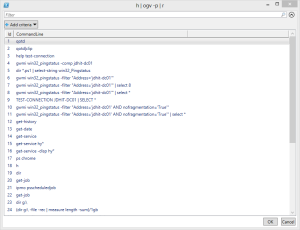One of my favorite features in PowerShell 3.0 is that you can select items in Out-Gridview which will then pipe the object back to the pipeline. One way I've been using this is as graphical "picker" for command history. I use Get-History, actually its alias h, all the time. Once I know the history number I then use Invoke-History, or its alias r. Now, with Out-Gridview, which has an alias of ogv, I can sneak in a little something extra.
ManageEngine ADManager Plus - Download Free Trial
Exclusive offer on ADManager Plus for US and UK regions. Claim now!
PS C:\> h | ogv -p | r
I realize this is cryptic but when using the shell interactively efficiency is paramount. This is the actual full command.
PS C:\> Get-History | Out-Gridview -passthru | Invoke-History
I'll get something like this:
I can select an item, click OK and the command will run back in my console. There are a few downsides, but remember this is a Friday Fun article. First, if you cancel, PowerShell will invoke the last command again. Also, as written if you select multiple items, which you could with -Passthru, you'll get an error because Invoke-History won't accept multiple entries. You could force Out-Gridview to only allow a single selection.
PS C:\> h | ogv -OutputMode Single | r
Or you could use Foreach to handle multiple selections.
PS C:\> h | ogv -p | %{r $_}
Be aware that when you run multiple commands in the same pipeline formatting can get a little screwy so I would probably stay way from it.
One more way you might use this is with Invoke-Expression (iex) instead of Invoke-History. The history object has a commandline property which you could invoke.
PS C:\> (h | select * | ogv -p).Commandline | iex
This will also handle multiple commands. If you cancel from Out-Gridview, Invoke-Expression will throw an exception but at least it won't try to re-run the last command which is probably better.
Again, these are all "quick and dirty" commands to have fun with from a PowerShell prompt.

